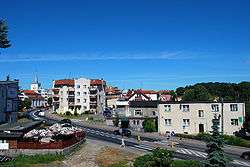Sztum
| Sztum | |||
|---|---|---|---|
|
View of Sztum | |||
| |||
 Sztum | |||
| Coordinates: 53°55′18″N 19°2′1″E / 53.92167°N 19.03361°E | |||
| Country |
| ||
| Voivodeship | Pomeranian | ||
| County | Sztum County | ||
| Gmina | Gmina Sztum | ||
| Established | 13th century | ||
| Town rights | 1416 | ||
| Government | |||
| • Mayor | Leszek Jan Tabor | ||
| Area | |||
| • Total | 4.59 km2 (1.77 sq mi) | ||
| Population (2006) | |||
| • Total | 9,945 | ||
| • Density | 2,200/km2 (5,600/sq mi) | ||
| Time zone | CET (UTC+1) | ||
| • Summer (DST) | CEST (UTC+2) | ||
| Postal code | 82-400 | ||
| Area code(s) | +48 55 | ||
| Car plates | GSZ | ||
| Website | http://sztum.pl | ||
Sztum ([ʂtum]) (German: Stuhm) is a town in northern Poland in the Powiśle region, located in the Pomeranian Voivodeship. It is the capital of Sztum County, with some 10,141 inhabitants (2004).
History

Signs of settlement dating back to the Roman Empire era have been found. In the early Middle Ages, a fortified settlement of the Prussian people existed at the site, conquered by the Teutonic Knights in 1236. City rights were granted to the settlement in 1416.
In 1466 the town with other western Prussian territory passed to the crown of Poland as part of Royal Prussia. As part of Poland, the town functioned as a seat of Sztum powiat in Malbork Voivodeship (1466-1772) and a place to hold local court sessions. In 1635 the Treaty of Stuhmsdorf was signed in the village of Stuhmsdorf (now Sztumska Wies, just south of the city of Sztum).
In 1772 during the time of the First Partition of Poland the town became part of the Kingdom of Prussia. In 1871 it became part of the newly created German Empire.
According to the Treaty of Versailles, after World War I the inhabitants were asked whether they want to remain in Germany or join the new Second Polish Republic in the East Prussian plebiscite of 1920. The German side engaged in mass persecution of Polish activists, their Masurian supporters, going as far as engaging in regular hunts and murder against them to influence the vote, and the voted was largely boycotted by ethnic Poles. Ultimately, 19,984 votes were counted to remain in Germany and 4,904 votes for Poland.[1] Based on that result Stuhm was included in the Regierungsbezirk Marienwerder within East Prussia.
After World War II the area was placed under Polish administration by the Potsdam Agreement under territorial changes demanded by the Soviet Union. Germans fled or were expelled and replaced with Poles expelled from the Polish areas annexed by the Soviet Union or forced to settle in the area through Operation Vistula in 1947.
Number of inhabitants by year
| Year | Number |
|---|---|
| 1789 | 509 |
| 1831 | 956 |
| 1875 | 2,145 |
| 1880 | 2,210 |
| 1890 | 2,265 |
| 1905 | 2,557 |
| 1933 | 6,147 |
| 1939 | 7,374 |
| 1943 | 7,099 |
| 2006 | 9,945 |
Notable residents
- Goetz Oertel (born 1934), physicist
- Jacob Malinowski (born 1997), pilot and sound lad
International relations
Twin towns — Sister cities
Sztum is twinned with: Ritterhude, Val de Reuil, Varde
References
- ↑ Rocznik statystyki Rzeczypospolitej Polskiej(pdf, 623 KB). Główny Urząd Statystyczny Rzeczypospolitej Polskiej GUS, Annual (Main Statistical Office of the Republic of Poland) (1920/1922, part II)
- ↑ Johann Friedrich Goldbeck: Volständige Topographie des Königreichs Preußen. Part II, Marienwerder 1789, p. 19.
- ↑ Meyers Großes Konversations-Lexikon, 6th edition, Vol. 8, Leipzig and Vienna 1907, p. 251.
- ↑ Michael Rademacher: Deutsche Verwaltungsgeschichte Provinz Westpreußen, Kreis Stuhm (2006).
- ↑ August Eduard Preuß: Preußische Landes- und Volkskunde. Königsberg 1835, p. 444, no. 59.
External links
- Official town webpage
- Stuhm on map of Germany, Prussia 1600
- Vital Statistics (Kirchenbuch) of inhabitants since mid 1600s of Stuhm city and Stuhm county
- German website of former Kreis Stuhm inhabitants
Coordinates: 53°56′N 19°02′E / 53.933°N 19.033°E



